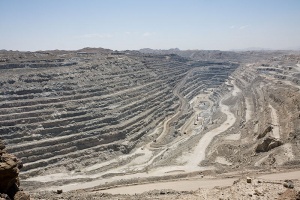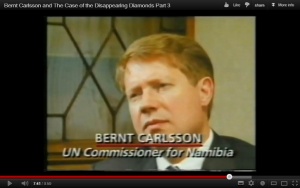Difference between revisions of "United Nations Commissioner for Namibia"
(Update) |
(Governor-in-waiting Bernt Carlsson killed on the eve of taking charge of Namibia) |
||
| Line 3: | Line 3: | ||
|image=Carlsson_Pan_Am_103.jpg | |image=Carlsson_Pan_Am_103.jpg | ||
|image_width=240px | |image_width=240px | ||
| + | |image_caption=Governor-in-waiting [[Bernt Carlsson]] killed on the eve of taking charge of [[Namibia]] | ||
|start=27 October 1966 | |start=27 October 1966 | ||
|end=21 December 1988 | |end=21 December 1988 | ||
Revision as of 12:11, 26 October 2016
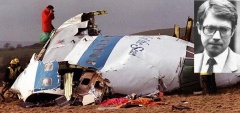 Governor-in-waiting Bernt Carlsson killed on the eve of taking charge of Namibia | |
| Start | 27 October 1966 |
| Abbreviation | UNCN |
| Chief Administrative Officer (Governor-in-waiting) of the UN Trust Territory Namibia, illegally occupied by apartheid South Africa (1971-1990) | |
The acronym UNCN stands for both the post of United Nations Commissioner for Namibia (left vacant after the seventh and last office holder Bernt Carlsson was murdered on 21 December 1988[1]) and the United Nations Council for Namibia, which the UN established in 1967 as occupied Namibia's only lawful Administering Authority.
The UN had terminated South Africa's mandate over Namibia in 1966. In 1971 the International Court of Justice ruled that the continued presence of South Africa in Namibia was illegal and as a result South Africa was under obligation to withdraw its administration from Namibia immediately and thus put an end to its occupation of the Territory. But South Africa refused to withdraw, and the liberation movement SWAPO had to continue its decades-long struggle for independence.[2]
Following the formal signing ceremony of the Namibian independence agreement at United Nations headquarters on 22 December 1988 (which UNCN Bernt Carlsson was prevented from attending), Namibia finally achieved independence on 21 March 1990. The other UNCN (UN Council for Namibia) was dissolved six months later.[3]
Contents
Background
Namibia — formerly known as South-West Africa — was the only one of the seven African Territories once held under the League of Nations Mandate System that was not placed under the Trusteeship System. The UN General Assembly (UNGA) recommended in 1946 that South Africa do so, but South Africa refused. Instead, South Africa informed the United Nations in 1949 that it would no longer transmit information on the Territory, on the grounds that the Mandate had lapsed with the demise of the League. In 1950, the International Court of Justice (ICJ) held that South Africa continued to have international obligations towards the Territory, and that the United Nations should exercise the supervisory functions of the League of Nations in the administration of the Territory. South Africa refused to accept the Court's opinion, and continued to oppose any form of United Nations supervision.
In 1966, the UN General Assembly declared that South Africa had failed to fulfil its obligations under the Mandate. It terminated that Mandate, and placed the territory under the direct responsibility of the United Nations. In 1967, the Assembly established the United Nations Council for South West Africa to administer the Territory until independence. It thus became the only Territory which the United Nations, rather than a Member State, assumed direct responsibility. In 1968, the Council was renamed the United Nations Council for Namibia, when the Assembly proclaimed that, in accordance with the wishes of its people, the Territory would be thenceforth known as Namibia. Later that year, in the face of South Africa's refusal to accept UNGA's decision and cooperate with the UN Council for Namibia, the Assembly recommended that the Security Council take measures to enable UNCN to carry out its mandate.
UN Commissioner for Namibia
United Nations Commissioner for Namibia (UNCN) was a post created by the United Nations General Assembly (UNGA) in 1966 to assert the UN's direct responsibility for South-West Africa (Namibia) which was then under illegal occupation by apartheid South Africa.[4][5] There were seven occupants of the post of UN Commissioner for Namibia. South Africa refused to recognise the authority of any of the UN Commissioners.
| Commissioner | Nationality | Term of office |
|---|---|---|
| Anton Vratuša | Yugoslavia | 27 October 1966 — 13 June 1967 |
| Konstantinos Stavropoulos | Greece | 13 June 1967 — 1 December 1969 (acting) |
| Agha Abdul Hamid | Pakistan | 1 December 1969 — 18 December 1973 (acting) |
| Seán MacBride | Ireland | 18 December 1973 — 1 January 1977 |
| Martti Ahtisaari | Finland | 1 January 1977 — 1 April 1982 |
| Brajesh Mishra | India | 1 April 1982 — 1 July 1987 |
| Bernt Carlsson | Sweden | 1 July 1987 — 21 December 1988 |
UNSCR 435
In its first resolution on the question, the UN Security Council, in 1969, recognised the termination of the Mandate, described the continued presence of South Africa as illegal, and called on South Africa to withdraw its administration immediately. In 1970, the Security Council declared for the first time that all acts taken by South Africa concerning Namibia after the termination of the mandate were "illegal and invalid". This view was upheld in 1971 by the International Court of Justice, which stated that South Africa's presence was illegal, and that South Africa was under obligation to withdraw its administration. South Africa, however, refused to comply with the UN resolutions, and continued its illegal administration of Namibia, including the imposition of apartheid laws, the bantustanisation of the Territory, and the exploitation of its resources.
In 1978, Canada, France, the Federal Republic of Germany, the United Kingdom and the United States (the so-called Contact Group) submitted to the UN Security Council a proposal for settling the question of Namibia. According to the proposal, elections for a Constituent Assembly would be held under United Nations auspices. Every stage of the electoral process would be conducted to the satisfaction of a Special Representative for Namibia appointed by the Secretary-General. The plan envisaged that a UN Transition Assistance Group would be at the disposal of the Special Representative to help him supervise the political process and to ensure that all parties observed all provisions of an agreed solution. By UNSCR 435 (1978), the Security Council endorsed the Contact Group plan for Namibia and decided to establish UNTAG.
In 1980, South Africa accepted the plan proposed by the five Powers and in 1981 participated in a pre-implementation meeting at Geneva. However, South Africa did not agree to proceed towards a ceasefire, one of the conditions set by UNSCR 435. Negotiations were again stalled when South Africa attached new conditions which the United Nations did not accept, in particular one which linked the independence of Namibia with the withdrawal of Cuban troops from Angola. In the following years, the UN Secretary-General and his Special Representative travelled extensively throughout southern Africa, discussing problems, clarifying positions, exploring new concepts and exchanging views with all parties. Various countries promoted talks on the issue — among them the five Western sponsors of the 1978 proposal and Zambia. Gradually the unresolved matters yielded to the give and take of negotiations.[6]
UNCN Decree
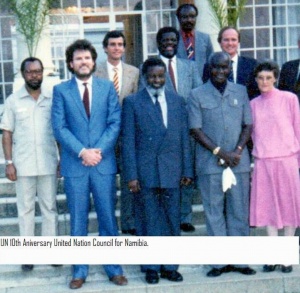
The UN Council for Namibia enacted in 1974 a Decree for the Protection of the Natural Resources of Namibia, under which no person or entity could search for, take or distribute any natural resources found in Namibia without the Council's permission. Any person or entity contravening the Decree could be held liable for damages by the future government of an independent Namibia. Also in 1974, the Council established the UN Institute for Namibia, located in Lusaka, Zambia. The Institute, which operated until after independence, provided Namibians with education and training equipping them to administer a free Namibia. In 1976 the Security Council for the first time demanded that South Africa accept elections for the Territory under United Nations supervision and control. In the same year, the General Assembly condemned South Africa for organising so-called constitutional talks at Windhoek, Namibia's capital, designed to perpetuate the colonial oppression and exploitation of Namibia. It decided that any independence talks must be between South Africa and the South West Africa People's Organisation (SWAPO), which the Assembly recognised as the sole and authentic representative of the Namibian people. The Assembly also launched a comprehensive assistance programme in support of Namibia's nationhood, involving assistance by United Nations organisations and specialised agencies.
In 1977, the Assembly declared that South Africa's decision to annex Walvis Bay — Namibia's main port and vital economic avenue — was illegal, null and void and an act of colonial expansion. At a special session on Namibia in 1978, the Assembly expressed support for the armed liberation struggle of Namibian people, and stated that any settlement must be arrived at with the agreement of SWAPO and within the framework of United Nations resolutions.[7]
Namibian Yellowcake
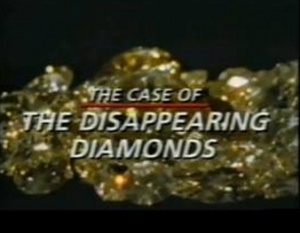
On 10 March 1980, the TV documentary "Follow the Yellowcake Road" was broadcast in the UK by Thames Television.[8] Synopsis of the film:
- "World In Action investigates the secret contract and operation arranged by British-based Rio Tinto Zinc Corp to import into Britain uranium (Yellowcake) from the Rössing Uranium Mine in Namibia, whose major shareholders are the governments of Iran and South Africa. This contract having received the blessing of the British government is now compromising the UK's position in the United Nations negotiations to remove apartheid South Africa from Namibia, which it is illegally occupying."[9]
In May 1985, the UN Council for Namibia decided to take legal action against the Dutch arm of the Anglo/Dutch/German consortium URENCO for breaching the UNCN Decree by importing uranium ore from the Rössing Uranium Mine in Namibia. The case was expected to be ready by the end of 1985 but was delayed because URENCO argued that, despite having enriched uranium of Namibian origin since 1980, it was impossible to tell where specific consignments came from. When the case finally reached court in July 1986, the Dutch government took URENCO's line, claiming not to have known where the uranium had been mined.[10]
Upon the adjournment of the URENCO proceedings, SWAPO's UN representative, Helmut Angula, insisted that other companies, such as Shell, De Beers (Consolidated Diamond Mines), Newmont, and Rio Tinto Group were also likely to face prosecution for breaching the UNCN Decree.[11]
Gem Diamonds
In a 28 September 1987 World In Action TV documentary ("The Case of the Disappearing Diamonds"), UNCN Bernt Carlsson warned that he intended to start proceedings against the countries and firms which had been defying UN law over many years by stealing billions of pounds' worth of Namibia's natural resources. Among those facing UN compensation claims were: the diamond mining firm De Beers; P W Botha's apartheid regime of South Africa; Rio Tinto Group, owners of the Rössing Uranium Mine; and, the government of Iran which today still owns 15% of Rössing and, in 1988-89, received large shipments of uranium from Namibia. When asked if he would be taking action against other companies such as De Beers, the diamond mining conglomerate, Bernt Carlsson told interviewer John Coates:
- "All the companies which are carrying out activities in Namibia which have not been authorised by the United Nations are being studied at present. As far as De Beers is concerned, the corporation has been trying to skim the cream which means they have gone for the large diamonds at the expense of the steady pace. In this way they have really shortened the lifespan of the mines. One would expect from a worldwide corporation like De Beers and Anglo American that they would behave with an element of social and political responsibility. But their behaviour in the specific case of Namibia has been one of profit maximation regardless of its social, economic, political and even legal responsibility."[12]
Because Bernt Carlsson was murdered on Pan Am Flight 103 at Lockerbie on 21 December 1988, none of those prosecutions ever took place. [13]
An Office Holder on Wikispooks
| Name | From | To |
|---|---|---|
| Martti Ahtisaari | 1 January 1977 | 1 April 1982 |
Related Documents
| Title | Type | Publication date | Author(s) | Description |
|---|---|---|---|---|
| Document:Lockerbie Bombing and my Reinstatement in HM Diplomatic Service | letter | 29 January 1997 | Patrick Haseldine | Former diplomat Patrick Haseldine writes to former Prime Minister James Callaghan |
| Document:Pan Am Flight 103: It was the Uranium | article | 6 January 2014 | Patrick Haseldine | Following Bernt Carlsson's untimely death in the Lockerbie bombing, the UN Council for Namibia inexplicably dropped the case against Britain's URENCO for illegally importing yellowcake from the Rössing Uranium Mine in Namibia. |
References
- ↑ "U.N. Officer on Flight 103"
- ↑ "Independence for Namibia Now! UN Council for Namibia"
- ↑ "Dissolution of the United Nations Council for Namibia"
- ↑ UN General Assembly resolution 2248 of 19 May 1967 established a UN Council for South-West Africa and UN Commissioner for South-West Africa
- ↑ UN General Assembly resolution 2372 of 12 June 1968 renamed UN Council for Namibia and UN Commissioner for Namibia
- ↑ "UN Security Council Resolution 435 of 29 September 1978"
- ↑ "Historical background - Namibia"
- ↑ "Follow The Yellowcake Road"
- ↑ World In Action "Follow The Yellowcake Road"
- ↑ "Council for Namibia sues Netherlands over Namibia's natural resources"
- ↑ "De Beers face prosecution"
- ↑ "Bernt Carlsson and the Case of the Disappearing Diamonds"
- ↑ "Murder of Bernt Carlsson must not go unpunished"

